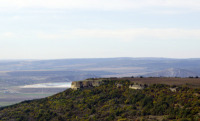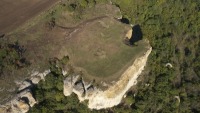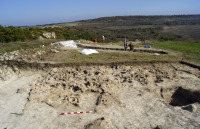Excavations in Avren, Bulgaria
Topic: Excavations at the Copper Age site of Avren, Bulgaria
Funding: Bulgarian Ministry of Culture and Institute of Prehistory, Heidelberg
Project directors: Maria Ivanova (University of Heidelberg) and Petar Leshtakov (Institute of Archaeology, Sofia)
Key words: Copper Age, Varna period, fortified sites
 |
The site: The chalcolithic site Bobata near Avren lies on a rocky protrusion with an area of 0,25 ha on the north-western edge of the Avren plateau. The site is approachable only from the north side, while the east, south and west sides are vertical and over 20 m high. The accessible north side is enclosed by a 65 m long, arc-shaped stone wall which is clearly recognizable on the surface as a 5-7 m wide stone belt. The site has a strategic defensive position, overlooking the major trade route leading from the lakes of Varna and Beloslav through the Balkan range via the low Aytos pass to Thrace. |
|
Excavations in 2014: A pilot season of excavations at Avren-Bobata took place in 2014 under the direction of Petar Leshtakov (Sofia) and Maria Ivanova (Heidelberg) in three areas covering 260 m2. The fieldwork was funded by the Bulgarian Ministry of Culture and the Institute of Prehistory, University of Heidelberg. |
 |
| A 12,20 m long section of the stone enclosure wall was uncovered. The wall is constructed of large undressed stones without mortar and is preserved to a maximal height of 1,60 m. The width of this structure was 1,80-2,00 m. The chacolithic cultural layer in the interior of the settlement is c. 1,30 m thick and includes two phases of habitation. The excavations in 2014 uncovered the well-preserved remains of burnt houses – collapsed wattle-and-daub walls, house floors, installations such as ovens as well as concentrations of finds in situ. The excavation of these structures will be completed in 2015. |
| Finds from the habitation strata include numerous ceramic sherds, animal bones, flint and bone tools, clay figurines, spindle whorls, and bone beads. All archaeological materials and features at the site date to the Late Chalcolithic period. |  |
| The results of the pilot season in 2014 confirm that Avren-Bobata was a one-period site dating to the Late Chalcolithic. Undisturbed layers of the fifth mill. BC lie immediately below the surface. The materials correspond typologically to the Late Chalcolithic finds from Durankulak and Varna I. The excavations demonstrate the exceptional preservation of Late Chalcolithic strata and features, in particular burnt dwellings with in situ inventories, at this site and thus its great potential for investigation of the Varna period. |
Contact:
Maria Ivanova ivanova@uni-heidelberg.de
Seitenbearbeiter:
E-Mail
Letzte Änderung:
28.05.2015

